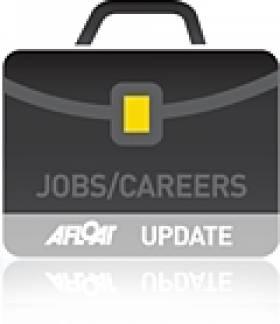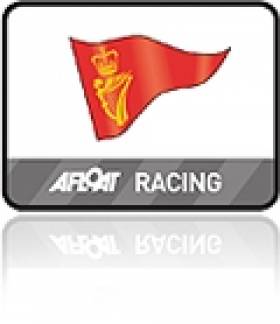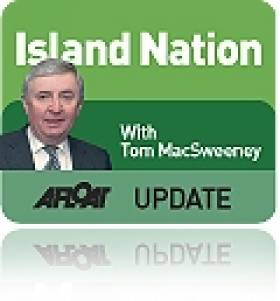Displaying items by tag: Crosshaven
Preparing for the Challenge of La Solitaire du Figaro
Dubliner Paul O'Riain's comprehensive article on his Figaro debut experience in 2007 has moved, Click this link for it and the latest La Solitaire du Figaro news.
Hugh Mockler Joins Crosshaven Boatyard
Crosshaven Boatyard Company Ltd has announced that Hugh Mockler, (formerly of HM Yachts Ltd), is to join long established yacht broker, Donal McClement in the Boatyard's new boat and brokerage sales division.
Matt Foley, General Manager of Crosshaven Boatyard, told Afloat, 'Donal and Hugh are two of the best known and most successful Yacht Brokers in Ireland. Over the past number of years and their combined knowledge of a very difficult market will ensure that the buyers and sellers get a top class service'. Hugh and Donal will be able to give buyers and sellers the best possible advice.'
Crosshaven Boatyard has been providing marine services for over 60 years.
The boatyard also specialises in all aspects of the repair and maintenance of modern pleasure boats. Many well-known boats such as Gypsy Moth V, the Saint Brendan, Longbow II and a series of Moondusters were completed in the1980s.
It was the first commercial marina, with a marine travel hoist, in Ireland in 1979. The yard is the Irish distributor for Dufour Yachts of France, and Grand Soleil, of Italy.

Hugh Mockler (left) is greeted by General Manager Matt Foley (centre) and yacht broker Donal McClement. Photo: Bob Bateman
Outstanding Anthony O'Leary is Worthy Sailor of the Year
Anthony O'Leary of Cork is the Afloat.ie/Irish Independent "Sailor of the Year" in celebration of his outstanding achievements afloat nationally and internationally throughout last season, and to honour his dedication to sailing in all its forms both as a participant and an administrator.
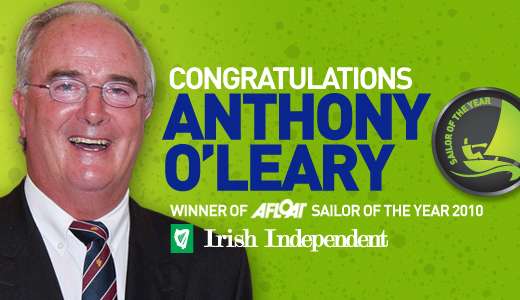
The O'Leary pace afloat and ashore belies his age of 53. During 2010, it was in May that he was "Sailor of the Month" for an already remarkable list of wins with his Ker 39 Antix. Having topped the April Series in Kinsale, he then won the Crosshaven-Dun Laoghaire race overall, went on to win his class and be one of the top points scorers in the ICRA Nationals in Dublin Bay, and then went on to Scotland to win his class overall with a nail biting brace of wins on the final day of the Scottish Series.
To achieve all that before May was out was exceptional, but the O'Leary progress was only beginning. The big picture was to maintain momentum towards the international Commodore's Cup in the Solent in August. Antix was one of the three boat squad, and her skipper was also the team captain in a campaign which was light years away from the glossy efforts which dominated the boom years of Irish affluence.

Anthony O'Leary takes on the waves at the helm of his yacht Antix during Cork week in Cork Harbour. Photo: Bob Bateman
In previous seasons, Ireland had been able to muster enough boats for two or even three teams, yet had never won despite being within inches of success. But this time round, only three boats were game for it, and only one – Rob Davis's Corby 36 Roxy – was new. Yet with Dave Dwyer's ever-keen Mills 39 marinerscove.ie filling the third slot, O'Leary headed a potent force, and he himself sailed with style and inspiring sportsmanship to give Ireland a commanding overall win.
Anthony O'Leary is the personification of Irish sailing at its very best. With the enthusiastic support of his wife Sally, he is father to a family which has logged outstanding sailing success at all levels. Yet he himself is in many ways the quintessential club sailor. He is as happy racing the Autumn series at Crosshaven with a 1720 or the West Cork regattas with a cruiser-racer, as he is competing at the highest levels. He has been among the front runners for the title of Ireland's "Sailor of the Year" several times. And now, as with all his wins, when he does do it, O'Leary does it with style.
Crosshaven Lifeboat Recover Body in Ringabella Bay
Crosshaven RNLI Lifeboat report that they have recovered the body of a missing fisherman from the sea at Ringabella Bay after information received from a person on shore. The fisherman was lost when the fishing boat sank almost four weeks ago.
Related Safety posts
RNLI Lifeboats in Ireland
Safety News
Rescue News from RNLI Lifeboats in Ireland
Coast Guard News from Ireland
Water Safety News from Ireland
Marine Casualty Investigation Board News
Marine Warnings
Royal Cork Seek Operations Manager
The Royal Cork Yacht Club is recruiting an Operations Manager on a fixed term contract basis.
The Club offers a full range of sailing facilities, comprising a 200 berth marina, 40 moorings, extensive dinghy facilities, seven-day hospitality service and a full 12-month schedule of sailing activities.
Operating from Crosshaven, Co. Cork, the Royal Cork Yacht Club celebrates the 300th anniversary of its founding in 2020.
A notice on the club website this afternoon says;
"We are seeking to recruit a senior individual who will provide overall leadership and management for our operations team, with responsibility for overseeing the Club facilities, hospitality services and sailing activities. He or she will also be involved in the advancement of the Club's ongoing infrastructural development plan.
Reporting to the Executive Committee, this is an exciting opportunity for a person with proven commercial, hospitality and marketing skills.
The person appointed will have senior management experience, preferably in a marine, or leisure environment, and must be able to demonstrate strong interpersonal, organisational and leadership capacities."
Please send applications and CV (by e-mail only) to [email protected]
National Award for Irish Cruiser Racing Association (ICRA)
In the three decades and more of the Mitsubishi Motors/Irish Independent "Sailing Club of the Year" assessments, there has never been an organization only seven years old winning the title.
In fact, seniority has often won the day, though in a country in which the oldest sailing clubs date from 1720 (Royal Cork) and 1770 (Lough Derg), it's difficult to find clubs and associations which are anything less than centenarians, let alone not yet in double figures.
But it was only as recently as June 2003 that the Irish Cruiser Racing Association came into being. It was at the biennial Sovereign's Cup series in Kinsale that Fintan Cairns of Dun Laoghaire, enthusiastically supported by the late Jim Donegan of Cork and other key personnel, successfully launched the idea of a nationwide organisation to co-ordinate the racing sport of "boats with lids".
At the time, it was a leap of vision. Having successfully headed Dublin Bay Sailing Club at a time of rapid growth, he was able to see the picture more clearly than those who reckoned that offshore racing organisations should be related to bodies of water rather than a land mass, for all that we're on an island.
Then too, the new association was envisaged as using established clubs and their facilities to stage its championship. In other words, the ICRA organising team would be the travelling people of the Irish sailing scene. On top of that, handicap competition with cruiser-racers was derided as "truck racing" by the white hot one design and dinghy sailors.
Yet the idea took hold, and the annual championship was successfully staged at venues as various as Crosshaven, Tralee, Howth, Kinsale and Dun Laoghaire, with Denis Kiely the essential ace number-cruncher in the back office. And in May 2010, with the mighty machine of the Royal St George YC in Dun Laoghaire providing the administrative centre, the Liebherr Irish Cruiser Nationals in Dublin Bay attracted a fleet of 117 boats, with great sailing.
On that event alone, ICRA would have been among the front runners for Club of the Year. But the best was yet to come. In recessionary times, getting a three boat team together to make a worthwhile challenge for the biennial Rolex International Commodore's Cup was a matter of making the best of limited resources. But ICRA – currently under the leadership of Barry Rose of Cork - was up to the job.
The team of Anthony O'Leary's Antix, Dave Dwyer's marinerscove.ie, and Rob Davis and Andrew Creighton's Roxy 6, had a convincing win. Thus ICRA in one season had catered very well for general run of boats and crews at home, and had come out tops at the top level internationally. It doesn't get better than that, and we salute them as Sailing Club of the Year 2011.
National 18s Aim for Big Turn-Out
The club hopes over 50 boats will participate across three separate divisions:-
Ultimates - The modern fibreglass boats of the racing fleet.
Penultimates - The older fiberglass boats that have been hiding in garages waiting to be taken out for the 2011 championship.
Classics - The beautiful wooden clinker-built boats that have re-surfaced in Crosshaven, West Cork and further afield in recent years.
More on this class by Tom MacSweeney HERE
Crosshaven Lifeboat Called out Twice on Last Day of 2010
The Volunteer crew members were awoken by pagers just after 4am, and requested to launch to the aid of a woman on rocks near Myrtleville. A combined rescue operation by the RNLI, Fire Service, Crosshaven Coastguard and the HSE brought the women to safety and onwards to hospital, where she is recovering.
The volunteer crews headed back to their beds at 6.30 in the morning.
The afternoon peace was shattered by the shrill sound of pagers, again calling the crew. Valentia Marine rescue Centre informed the station of a 38 foot commercial fishing vessel which had become entangled in its own nets. The volunteer crew of Con Crowley, Gary Heslin and Vincent Fleming made their way through a moderate to rough sea to the vessel which was near Power Head. As the vessels nets were also attached to the seabed, the nets had to be cut away before the Lifeboat could establish a tow back to Crosshaven, arriving some two hours later.
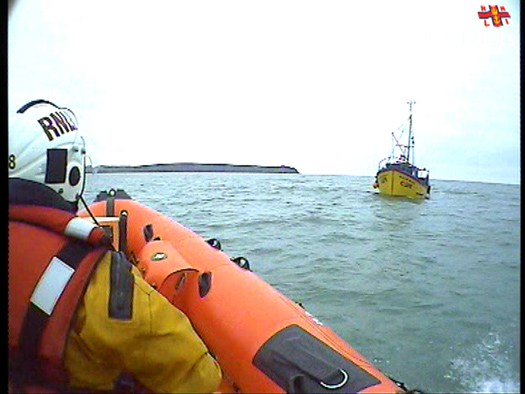
A video grab of the afternoon service yesterday to the disabled Fishing Vessel. Photo: Crosshaven Lifeboat Station
Related Safety posts
RNLI Lifeboats in Ireland
Safety News
Rescue News from RNLI Lifeboats in Ireland
Coast Guard News from Ireland
Water Safety News from Ireland
Marine Casualty Investigation Board News
Marine Warnings
Selection Procedure for Team Racing Worlds Underway
The selection procedure to designate the teams to represent Ireland at the ISAF Team Racing Worlds is underway.
Teams wishing to be considered for selection should contact the Irish Team Racing Association a [email protected]. A selection committee will then invite teams to trials to be sailed early in 2011. Invitations will be issued on the basis of the results of all team members (helm and crew) in 2009 -2010.
The trials will consist of a multiple round robin event. The Youth trials will be sailed in Crosshaven, and the senior trials in Dun Laoghaire. Unfortunately, the number of places available for Ireland at the World Championships is not yet known, but ITRA will select two senior teams, plus a reserve team, and two Youth teams, plus a reserve.
National 18s -72 Years Old and Still Sailing
My first experience of racing was in a National 18 wooden dinghy and it was rough. Inexperienced as a crewman during a race in Monkstown Bay, I slit the top of a finger across a chain plate while pulling in the headsail sheet.
Blood started to pour out of the cut. With the dinghy having only a short freeboard I did what seemed best. To avoid getting blood on the sail which is a heinous crime aboard sailing boats, I put my hand in the water to wash away the blood.
A roar from astern heralded the Skipper's response:
"Get your b....hand out of the water, you're causing drag," which meant I was being accused of the crime of slowing the boat down in a race where there was little wind and every bit of forward momentum was important.
I began to explain and made the mistake of asking where I should put my bloodied finger!
The answer is not printable, but taught me that National 18s didn't take competitive sailing lightly.
I grew to love those boats, their beautiful lines, their speed and their demands on the crew with a spinnaker up. Inevitably, with the cost of maintaining wooden boats, the glass fibre boats (GRP), took over, but the National 18 Class kept going, primarily based in Crosshaven.
Then the 1720s arrived, named after the year when the Royal Cork Yacht Club was founded, powerful new boats which were predicted to wipe out the National 18s. They didn't. Despite becoming very popular for a time, their support declined and the National 18s continued, not alone surviving, but strengthening
This week the Class has announced that it intends to host "the largest gathering of National 18s in the history of this legendary boat."
Next year's Class Championships, better known as the Cock O' the North and sailed in alternative years in Ireland and the UK, where the National 18 is also popular, will be held in Crosshaven from July 24 to 29.
"We are calling on everyone interested to get in touch and take part in what is going to be a great occasion, whether you are a former 18 sailor or someone looking for a new challenge," Class Captain Peter O'Donovan told me. "We are putting in a big effort to get former 18 sailors and their boats back on the water."
It is hoped that at least 50 boats will take part "and perhaps even more," said Peter who has been trawling class records to find former owners and boats which will be arranged in three divisions for the event.
"We decided to include a Classics section, which will encourage those who owned the beautiful wooden, clinker boats, to sail again with us. Some of these boats have reappeared in Crosshaven, we know of others in West Cork and further afield," said Peter.
There will be a section for the "Penultimates," the older fibreglass 18s which "have been hiding in garages, just waiting to be taken out again" and the "Ultimates," the modern fibreglass boats at the front of the present fleet.
"We want to make this a special event and so far there has been interest from Schull, Baltimore, Waterford, Wexford, Arklow and Lough Derg. Further afield, we expect to see visitors from Scotland, the Isle of Man, Essex, Tamesis and Chichester Harbour and we have even had a request for information from Germany."
One of the famous boat building family in Arklow, James Tyrrell, is amongst those who have owned and sailed a National 18. Another sailor of the boats was Peter Crowley, present Chairman of the Irish Sailing Association.
He sailed with Tommy Dwyer from Monkstown who is regarded as an icon of the National 18 fleet in Cobblerod. Tommy now sails Das Boot.
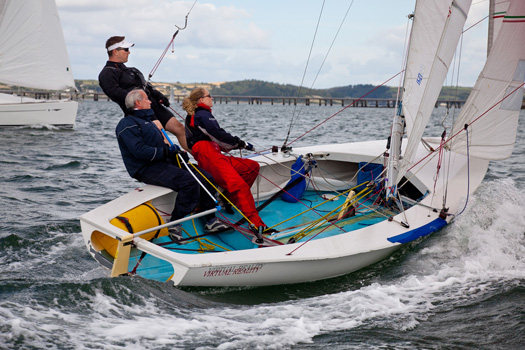
Fun in the National 18. Photo: Bob Bateman
"She was recovered from the bottom of Cork Harbour and I refurbished her. said Tommy, "We named her after the U-boat which featured in the film of that name."Tommy has been sailing National 18s for over 40 years. Every year his name has been amongst the trophy winners.
"For those interested in sailing, we would like to hear from those who would like to crew in the championships," Peter O'Donovan told me. "In addition, we are compiling a list of boats available for charter across the three divisions. For anyone not looking to sail, but just to be part of the event, we will also require assistance with rescue vessels, committee boats and other aspects of the event. It is also hoped to put together a collection of photographs from days gone. We would like to hear from anybody with material. Former 18 sailors who cannot get involved in the event could join us at the Class Dinner and renew acquaintances."
Anyone interested can contact the National 18 class by Emailing Peter O'Donovan at [email protected] or on phone 087 2491720 or Email Kieran O'Connell at [email protected]
The original idea for the building of National 18s was that of Frank Knowling of Whitstable YC in the UK, who later became known as the 'father' of the class. In 1938 he wanted an 18-foot dinghy, suitable for day sailing, yet fast enough to be of interest to racing sailors and at a reasonable cost.
The UK national sailing association and Yachting World magazine organised a design competition won by well-known designer Uffa Fox with a proposal for a clinker-built wooden boat. Another major designer, ¸, had also submitted a proposed boat. The first National 18 was named 'Hurricane,' owned by Stanley Beale and sailed at Whitstable.
It was not until after World War that building of 18s got underway. The Class Association was established in 1947 and by 1950 fleets had appeared at clubs around the coast of Britain and Ireland.
Seventy-two years after the first moves to build National 18s they still survive, a tribute to a great boat.

This article is reprinted by permission of the EVENING ECHO newspaper, Cork, where Tom MacSweeney writes maritime columns twice weekly. Evening Echo website: www.eecho.ie































